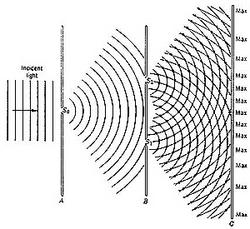The de Broglie Wavelength of a Packet of Light

In his 1924 doctoral dissertation the French physicist Louis de Broglie suggested that a wavelength is associated with any particle, and it was found that on a quantum level particles like electrons do indeed exhibit wavelike phenomena such as interference and diffraction. In the 5 April PRL, physicists present experimental evidence for the existence of a photonic de Broglie wavelength–wave features associated with a packet of photons interfering with itself.
In 1994 Joseph Jacobson and Yoshihisa Yamamoto of Stanford University predicted that a packet of more than one photon–multiple photons bound together–would have a de Broglie wavelength reduced from that of each photon’s individual wavelength, the reduction being inversely proportional to the number of photons. A dramatic reduction of the wavelength would be possible if all of the photons, as a whole, were divided into two paths by a special beam splitter–a 1,000 photon wave packet of green light would have the de Broglie wavelength of an x-ray, for example.
Sebastião de Pádua and his colleagues at Federal University of Minas Gerais in Brazil were able to verify this prediction for the two-photon case (a biphoton) by performing a clever experiment that measures the interference effects of the wave packet after it was sent through a simple double slit. By preparing the two-photon light state in different ways, they were able to measure the de Broglie wavelength of the two-photon packet as a whole or of its constituent quanta. They verified Yamamoto’s prediction for the case of two photons, the first evidence for his prediction of the general case.
The researchers generated the twin photons by a process called “spontaneous parametric down-conversion,” in which a crystal which has nonlinear optical properties can absorb a single photon and emit a pair of photons, each with half the energy of the original. They found that the key to their experiment lay in modification of the Argon laser beam they used to generate the photons. By placing a wire in front of the beam, they were able to change its intensity in directions perpendicular to the beam’s direction, and by focusing this wire onto the double slit they were able to observe the interference pattern of the wave packet interfering with itself. They found the characteristic pattern with wavelength half that of each individual photon.
“What’s interesting in this experiment,” said Pádua, “is that you can see the interference of the two photon packet as a whole with itself, and you can see the interference with each quanta of the two-photon packet with itself. And you can separate the two effects by manipulating the pump laser beam.”
Yamamoto hopes the group’s work will encourage others. “This is the first experimental evidence for the existence of the photonic de Broglie wavelength, even for two photons,” he said. “This experiment hopefully will trigger the effort to observe larger wave packets.” However, that requires a nonlinear beam splitter–one that splits photons not individually, but which splits the packet as a whole. “This is non trivial,” said Yamamoto.
–David Appell
David Appell is a freelance science writer.


